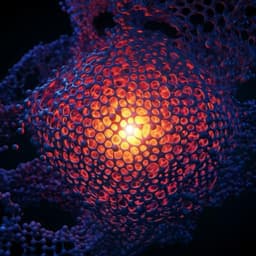
Chemistry
Halide perovskites as disposable epitaxial templates for the phase-selective synthesis of lead sulfochloride nanocrystals
S. Toso, M. Imran, et al.
This groundbreaking study reveals how CsPbCl3 perovskite nanocrystals can selectively synthesize lead sulfochlorides, such as Pb3S2Cl2 and Pb4S3Cl2. By controlling the process of nucleation and templating, researchers were able to produce phase-pure Pb4S3Cl2 nanocrystals with striking optoelectronic properties. This research was conducted by a team of experts including Stefano Toso and Muhammad Imran.
~3 min • Beginner • English
Introduction
The study addresses a central challenge in colloidal nanocrystal synthesis: controlling phase selectivity when multiple stoichiometries and structures are thermodynamically or kinetically accessible, often leading to impurities or undesired products. Drawing inspiration from reaction-directing groups in organic synthesis, the authors propose and test the concept of using halide perovskite nanocrystals (CsPbCl3) as disposable epitaxial templates to bias nucleation and growth toward a targeted lead sulfochloride phase. The hypothesis is that the continuity of the cationic subnetwork across an epitaxial interface between CsPbCl3 and a specific lead sulfochloride will favor selective heterogeneous nucleation of that phase (Pb4S3Cl2), while suppressing the homogeneously nucleated competing phase (Pb3S2Cl2). The approach aims to enable deterministic synthesis of otherwise inaccessible phases and to probe how structural factors and stoichiometry influence optoelectronic properties in lead chalcohalides.
Literature Review
The work builds on extensive literature in colloidal nanocrystal syntheses, including lead chalcogenides and halide perovskites, and on concepts of epitaxy and heterostructure formation in Cs–Pb–X systems. Previous studies highlighted metamorphoses and interconversions among Cs–Pb–halide phases and the pivotal role of the Cs+ cationic subnetwork in stabilizing interfaces in CsPb2X5/CsPbX3 heterostructures. Earlier reports by the authors on Pb4S3Br2/CsPbX3 heterostructures suggested structural affinity between lead chalcohalides and perovskites via cationic subnetworks. The analogy to removable directing groups from organic catalysis motivates using perovskites as phase-selective, sacrificial templates. The electronic properties of lead chalcohalides (Pb4S3Br2, Pb4S3I2) were previously observed to be relatively insensitive to halide identity, hinting at band-edge states dominated by Pb2+ and S2−, a trend examined here for Cl-containing phases. The study also relates to observations of PbCl2-rich shells on PbS nanocrystals synthesized with PbCl2, suggesting potential formation of sulfochloride-like surface layers under certain conditions.
Methodology
Synthesis: Multiple colloidal syntheses were developed.
- S-ODE stock (sulfur-in-ODE) for sulfochloride synthesis: 0.064 g S (2 mmol) dissolved in 10 mL degassed ODE in N2 glovebox via sonication.
- Direct synthesis of Pb3S2Cl2 NCs: PbCl2 (0.21 g, 0.8 mmol) in OLA/OA/ODE heated to 170 °C; inject 2 mL pre-heated S-ODE; nucleation in 10–30 s; quench after 1 min; purify via ethyl acetate precipitation/centrifugation and redispersion.
- Seeded growth (accretion) to obtain larger Pb4S3Cl2 NCs: Prepare stock with PbCl2 (1.06 mmol) and Pb(SCN)2 (2.13 mmol) in OLA/OA/ODE at ≤120 °C; use crude Pb4S3Cl2 reaction mixture as seeds at 170 °C; add stock at 10 mL/h via syringe pump; purify and filter to remove any PbS; obtain 29.5 ± 2.0 nm NCs used for structure solution.
- Pb4S3Br2 and Pb4S3I2 NCs synthesized per prior protocols for structural comparison and refinement.
- Cs-oleate precursor: Cs2CO3 in OA/ODE, dried and heated to 150 °C until clear.
- PbCl2 stock for nanoclusters: PbCl2 in OA/OLA/ODE, degassed and dissolved.
- Pb(OA)2 stock: Pb(OAc)2·3H2O reacted with OA in ODE under N2.
- CsPbCl3 nanoclusters: Mix PbCl2 stock with Cs-oleate at 40 °C for 20 min; isolate precipitate and redisperse in ODE.
- Formation of Pb4S3Cl2/CsPbCl3 heterostructures: At 200 °C in ODE, add Pb(OA)2 and DDT; rapidly inject mixture of sulfur and CsPbCl3 nanoclusters; react 5 min, quench; isolate via methyl acetate antisolvent; optional surface reconstruction by adding PbCl2 in ODE with OA/OLA to restore CsPbCl3 surface and long-term colloidal stability.
- Control synthesis of CsPbCl3 NCs: Seed-cluster solution injected at 150 °C, annealed 5 min, isolated.
- Selective etching of heterostructures to obtain phase-pure Pb4S3Cl2 NCs: Treat hexane dispersion with oleylamine; add equal volume DMF, vortex to form emulsion; remove DMF after phase separation; add pre-dried oleic acid; precipitate with methyl acetate, centrifuge, redisperse in toluene.
Characterization:
- TEM (JEOL-1100, 100 kV) for morphology and size.
- High-resolution HAADF-STEM (Thermo Fisher Themis Z, 300 kV) for lattice imaging; quantitative column intensity analysis with StatSTEM.
- Lab XRPD (Panalytical Empyrean, Cu Kα, PIXcel3D) and synchrotron XRPD/PDF (NSLS-II 28ID-2, 67.17 keV) for structure; data processing with FIT2D and PDFGetX3; modeling and refinement using PDFGUI and DiffPy-CMI; structure solution via 3D-ED (Zeiss Libra 120 kV, Timepix detector) and XRPD with EXPO2014; crystal visualization with VESTA.
- Optical spectroscopy: Absorbance (Cary 500) and PL (Cary Eclipse); excitation at 350 nm; transient PL using pulsed Nd:YAG (355 and 532 nm), detection with spectrometer/monochromator-PMT; temperature-dependent PL in LN2-cooled cryostat.
Computational methods:
- DFT (CP2K 8.1) with PBE functional and DZVP basis; scalar relativistic ECPs. Compared monoclinic vs hypothetical cubic Pb3S2Cl2 in 2×2×2 supercells; monoclinic found more stable by 164 kcal/mol.
- DFT calculations on NC models and heterostructures: electronic structure, band alignment, and Inverse Participation Ratio (IPR) computed to assess state localization and trap states; visualization of molecular orbitals and domain contributions.
Key Findings
- Phase-selective synthesis via perovskite templating: In homogeneous solution, lead sulfochlorides nucleate as Pb3S2Cl2 NCs. In the presence of CsPbCl3 nanoclusters, Pb4S3Cl2/CsPbCl3 epitaxial heterostructures form selectively due to continuity of the cationic (Pb2+/Cs+) subnetwork across the interface; such continuity is absent for a hypothetical Pb3S2Cl2/CsPbCl3 interface.
- Structural confirmation: HAADF-STEM and FFT analyses show a perovskite CsPbCl3 domain and a lead sulfochloride domain with unit-cell parameters and symmetry consistent with Pb4SX2 (by analogy to Pb4S3Br2/CsPbX3). Column intensity maps corroborate cationic subnetwork continuity across the interface.
- Disposable template: Selective DMF-assisted etching of CsPbCl3 domains yields phase-pure Pb4S3Cl2 NCs, preserving the chalcohalide crystal structure; morphology evolves to spherical, likely to minimize surface energy via recrystallization of ions released during etching.
- Optoelectronic properties:
• Free-standing Pb3S2Cl2 and Pb4S3Cl2 NCs exhibit overlapping, featureless absorption with onset at ~1.8 eV (~690 nm), indicating indirect band gaps (~1.8 eV) consistent with DFT.
• Heterostructures combine sulfochloride absorption with the perovskite edge (~3.1 eV, 400 nm), which is blunted versus sharp in free-standing CsPbCl3, indicating electronic coupling.
• Almost complete quenching of CsPbCl3 PL in heterostructures; PL decay at ~410 nm accelerates from τavg ~18 ps (free CsPbCl3) to ~8 ps (in heterostructures), consistent with carrier transfer.
• DFT predicts nearly type-I band alignment with band-edge states localized on the Pb4S3Cl2 domain; IPR reveals many localized trap states near the band edges.
• All sulfochloride-containing samples show a broad band-edge PL at ~1.8 eV with very low PLQY at room temperature (<1%) due to thermal quenching; at 77 K, PL intensifies ~100×, with non-exponential decays showing dominant sub-µs components and an activation energy of ~15 meV extracted from Arrhenius fits; spectral peak shifts toward ~1.5 eV (~827 nm) and narrows upon cooling.
- Structure/stoichiometry insensitivity: Electronic properties of lead sulfochlorides are largely insensitive to stoichiometry (Pb3S2Cl2 vs Pb4S3Cl2) and structure, and almost halide-insensitive, due to band-edge states dominated by Pb2+ and S2− and similar coordination polyhedra connectivity across phases.
- New structural insight: The discovered Pb3S2Cl2 structure shows Cl coordinated by an octahedron of Pb2+ ions, distinct from Br− and I− cases, aligning with observations of PbCl2-rich shells on PbS NCs synthesized with PbCl2.
Discussion
The findings validate the hypothesis that structural affinity and cationic subnetwork continuity across an epitaxial interface can direct phase-selective nucleation in complex multicomponent colloidal systems. CsPbCl3 nanoclusters act as reaction-directing, disposable templates that bias nucleation toward Pb4S3Cl2, suppressing the thermodynamically accessible, homogeneously nucleated Pb3S2Cl2. This demonstrates a practical route to control product phase in systems with competing polymorphs/stochiometries. The ability to subsequently remove the perovskite domain via selective etching yields phase-pure Pb4S3Cl2 NCs not accessible by direct synthesis, highlighting the template’s sacrificial role akin to directing groups in organic chemistry. Optoelectronic measurements and DFT show that both Pb3S2Cl2 and Pb4S3Cl2 possess similar indirect bandgaps (~1.8 eV) and temperature-activated PL behavior, reinforcing that their electronic structure is governed by Pb and S states with minimal halide contribution at the band edges. In heterostructures, quasi-type-I alignment promotes carrier localization within the sulfochloride domain, explaining PL quenching of CsPbCl3 and accelerated decay, while the perovskite domain can passivate some sulfochloride surface traps, yielding slightly more intense PL. These insights underscore the importance of cationic subnetworks in stabilizing epitaxial interfaces and open avenues to rationally design heterostructures and access otherwise elusive phases.
Conclusion
This work introduces halide perovskite nanocrystals (CsPbCl3) as disposable, phase-selective epitaxial templates to deterministically synthesize lead sulfochloride nanocrystals. The approach enables selective formation of Pb4S3Cl2/CsPbCl3 heterostructures and, after selective etching, phase-pure Pb4S3Cl2 NCs that cannot be obtained directly. Homogeneous nucleation in the absence of the template yields Pb3S2Cl2, demonstrating controllable product selection between competing phases. Comprehensive structural, spectroscopic, and computational analyses reveal that lead sulfochlorides possess similar, indirect bandgap optoelectronics largely insensitive to stoichiometry and structure, with band-edge states localized on Pb and S. The concept parallels removable directing groups in organic chemistry and can be generalized to other material systems with predictable epitaxial relations. Future research could extend templated synthesis to selenium/tellurium chalcohalides, pseudohalide-containing compounds (e.g., CN−, SCN−), and explore template libraries to access materials limited by high homogeneous nucleation barriers or competitive undesired phases. Further work should aim to reduce trap densities and enhance radiative efficiencies, and to map epitaxial compatibility rules across broader chemistries.
Limitations
- The desired Pb4S3Cl2 phase could not be obtained via direct homogeneous synthesis; it required a specific CsPbCl3 template and post-synthesis etching, which may limit scalability and generality across chemistries.
- Optical properties exhibit low PLQY at room temperature due to thermal quenching and prevalent trap states near band edges, as indicated by IPR analysis; improving surface passivation remains necessary.
- The study focuses on CsPbCl3 templates and Cl-containing sulfochlorides; broader validation across different perovskite templates, chalcogens (Se, Te), or pseudohalides is prospective rather than demonstrated.
- Morphology changes during etching (hemisphere to sphere) suggest surface reconstruction driven by released ions; controlling shape and surface terminations post-etching may be challenging.
- While cationic subnetwork continuity rationalizes phase selectivity, quantitative interfacial energetics and kinetics were inferred rather than directly measured, and long-term stability under operational conditions was not assessed.
Related Publications
Explore these studies to deepen your understanding of the subject.







